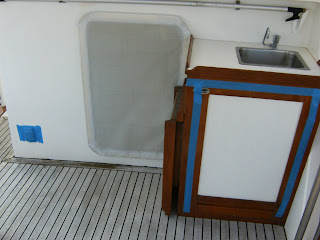 The last thing we did before we left Maya to come home was to prepare her for the worst...a hurricane. Of all the challenges a boater can face, this is the biggest.
The last thing we did before we left Maya to come home was to prepare her for the worst...a hurricane. Of all the challenges a boater can face, this is the biggest. We are not 'liveaboards' and most likely would not be physically present when and if the National Weather Service posted a hurricane warning. With that in mind, we had to prepare Maya with the assumption that during our absence, she might be caught in the crosshairs of one of these storms.
We all know that hurricanes can produce winds in excess of 150 miles per hour and dump several feet of rain in the space of a few hours. On top of that, the storm surge and tidal fluctuations can raise the water levels in excess of 15 feet above normal. Ironically however, the greatest danger to your vessel is not mother nature's wrath. The greatest danger comes from the guy in the boat next to you.
That's right. Depending how well your buddy next door (or in a slip across the way) prepares his boat, your chances of coming out of the storm unscathed increases dramatically. You see, most boats are damaged because another boat wasn't tied down properly and gets loose during the storm. At that point, the wayward ship becomes a 20 ton projectile, careening around the marina like a bull in a china shop. If you are unlucky enough that his boat puts a hole in yours, you are sunk. Literally.
I have heard that the safest place for your boat during a big 'blow' is to be anchored out at sea. That way, you don't have to worry about being slammed into by another ship. I cannot imagine little Maya being whipped around out in open waters, much less with Kim and me onboard. That is why we buy insurance... so we can sit it out in front of the Weather Channel at home in our living room.

That being said, there are some other things you can do to minimize the collateral damage. In a hurricane, the rain comes from all directions...above, below and sideways. If there is a crack or a seam that is open to the elements, water will get in. Additionally, the strong winds will blow anything that is not tied down into the next county. We spent the better part of a day taping up the spaces between the doors and the jambs, electrical outlets, windows and anywhere else we thought water might like to penetrate.
We also took down the bimini top that keeps us shaded up on the flybridge. That project caused me some worry. Maya has a very wonderful canvas bimini. It covers almost the entire length of the flybridge. You also can completely enclose the area with screening so you can sit outside at night, uptop, without being eaten alive by the bugs. It is fashioned together with literally hundreds of snaps, clips and zippers, none of which are marked. Apart, the bimini consists of 10 sections... all very large and bulky. Think of a giant jigsaw puzzle and you will get my drift.
About half way through the dismantling, it dawned on me that putting this thing back up was not going to be so easy. I am not really sure where to begin. Its like a Rubik's cube and sudoku rolled into one. All I know is that it will definitely be a two person affair and that communication and temper management will be key. I promise to have my video camera ready to record the event and I will post it later on YouTube for all to see. It will be for your entertainment and my protection.






